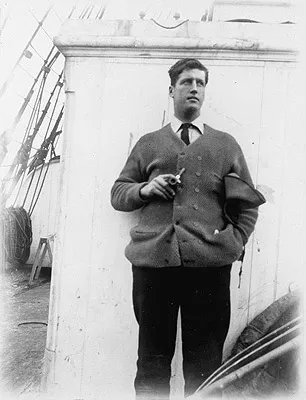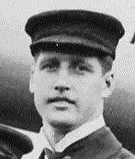Hartley Travers Ferrar
(1879 - 1932)
Biographical
notes
Geologist Discovery 1901-04

Hartley Ferrar was born in 1879 in Dalkey, a suburb of Dublin, Ireland. He had lived much of his life in Durban, South Africa where he had moved with his parents at an early age, his father was a bank manager. He returned to England to be educated, first at Oundle School, Northamptonshire and then as a geologist at Sidney Sussex College Cambridge.
Ferrar graduated in June 1901, he was appointed geologist to the Discovery Expedition a month later in July and set sail for Antarctica in the August. He was not an experienced geologist and was not at all well prepared for the work he would encounter in the South though spent much time applying himself to bookwork and study to learn all he could in the time available. He was one of the men who reinforced Scott's idea that young fit men should be taken on Antarctic expeditions despite the relative lack of experience, as Scott puts it:
"...the result of Ferrar's work was to throw considerable light on the structure of a vast land mass, no inconsiderable proportion of the surface of the earth; it was a result, therefore that cannot but be highly important to geological science, and it was achieved by physical labour which might not have been within the powers of a more experienced geologist"

After Shackleton's departure from the expedition he also took over his role of sea-water analysis in addition to being a geologist.
In 1905 he went to Egypt to join the geological section of the Survey Department where he remained until 1913 when he went to New Zealand to be Master of Christchurch College.
During the First World War he was part of the New Zealand Expeditionary Force in Palestine.
After the war in 1919 he joined the New Zealand Geological Survey until his death in New Zealand in 1932.
Landmarks named after Hartley Ferrar
Feature Name: Ferrar GlacierType: glacier
Latitude: 77°46'S
Longitude: 163°00'E
Description: Glacier about 35 mi long, flowing from the plateau of Victoria Land west of the Royal Society Range to New Harbour in McMurdo Sound. The glacier makes a right (east) turn northeast of Knobhead, where it is apposed, i.e., joined in Siamese-twin fashion, to Taylor Glacier. From there, it continues east along the south side of Kukri Hills to New Harbour. Discovered by the BrNAE (1901-04) under Capt. Robert F. Scott, R.N. The name Ferrar Glacier was originally applied both to the part of this glacier below its right turn and to the present Taylor Glacier. Griffith Taylor, geologist of the BrAE (1910-14) under Scott, found evidence that these are not two parts of a single glacier but are two glaciers apposed. With this discovery Scott gave the names Ferrar Glacier and Taylor Glacier essentially as now applied; the Taylor Glacier (q.v.) makes a left turn at Cavendish Rocks and drains east along the north side of Kukri Hills.
Variant Name(s)
-------------
East Fork
Lower Ferrar Glacier
New Harbour Glacier
South Arm
Biographical information
- I am concentrating on the Polar experiences of the men involved.
Any further information or pictures visitors may have will be gratefully received.
Please email
- Paul Ward, webmaster.
What are the chances that my ancestor was an unsung part of the Heroic Age
of Antarctic Exploration?
